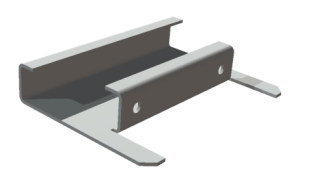The Autodesk Inventor software provides functionality that simplifies the creation, editing, and documentation of digital prototypes of sheet metal components
A sheet metal part is often thought of as a part fabricated from a sheet of uniformly thick material. If you design small objects, this material is often thin. However, in Autodesk Inventor you can utilize the sheet metal commands on any design where the material is of uniform thickness.

Within the Autodesk Inventor design environment, a sheet metal part can be displayed as a folded model or a flat pattern. With sheet metal commands, you can unfold features and work on a model in a flattened state, and then refold the features.
Create sheet metal parts
You create sheet metal parts from a template file. The sheet metal template file incorporates a set of rules. The rules determine some common attributes such as material type and thickness, unfolding rules, gap sizes, and so on. By changing a single rule, you can change the material of a sheet metal part from aluminum to stainless steel. A change of material often requires changes to the attributes that define bends and corners. Such changes often require changes to shop floor machinery and set-ups used to fabricate the parts.
Like other parts created within Autodesk Inventor, sheet metal parts begin with a base feature. The base feature of a sheet metal part is often a single face of some shape to which other features (often flanges) are added. A complex design could use a contour flange or contour roll as the initial base feature. Some parts could utilize a lofted flange as the initial feature.
Unlike regular parts, sheet metal parts are always created from a uniformly thick sheet that is flat. This sheet is formed into the final part using various fabrication techniques. In the sheet metal environment, you can create a folded model and unfold it into a flat pattern. The flat pattern is typically used to detail the fabrication. The sheet metal commands you use to work with flat patterns can provide critical fabrication information.
Convert parts to sheet metal parts
If a regular part created in Autodesk Inventor is of a consistent thickness, you can convert it to a sheet metal part. The same is true for parts imported from other systems.